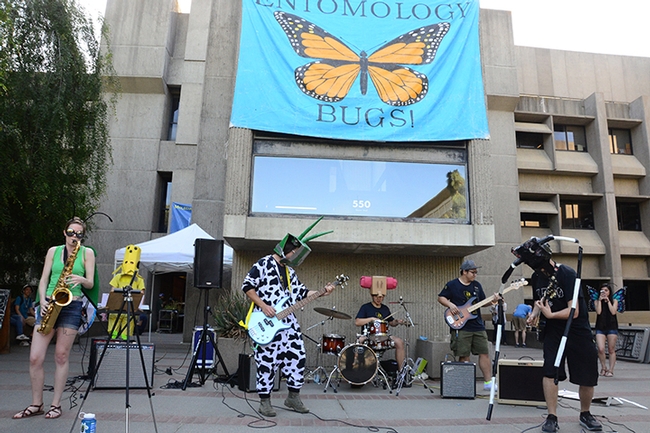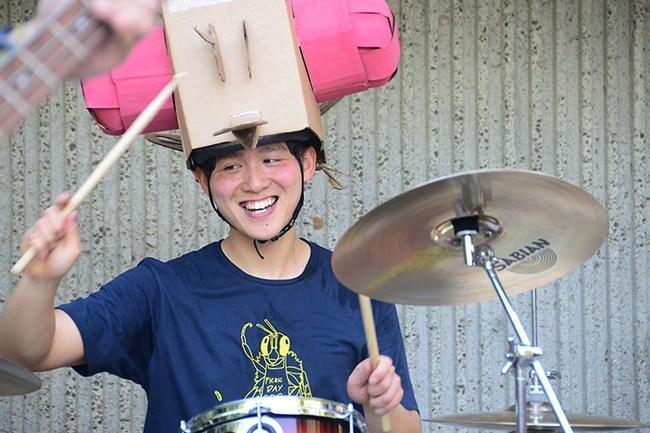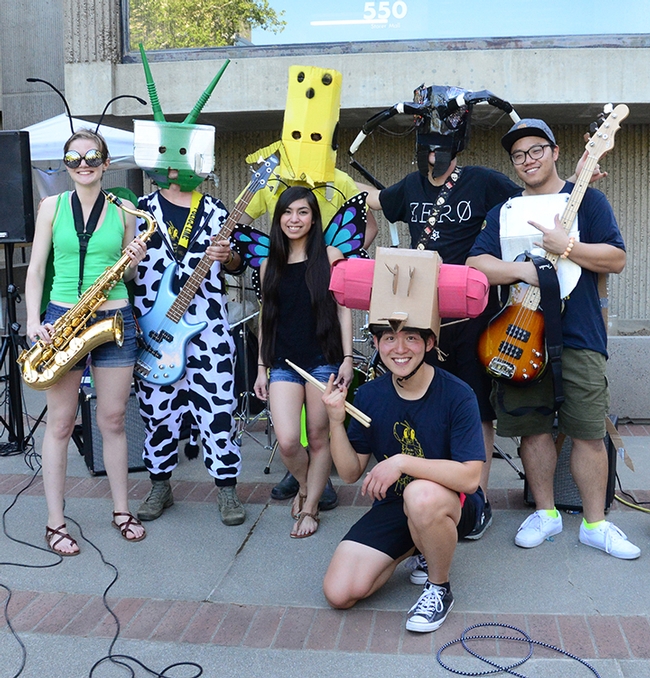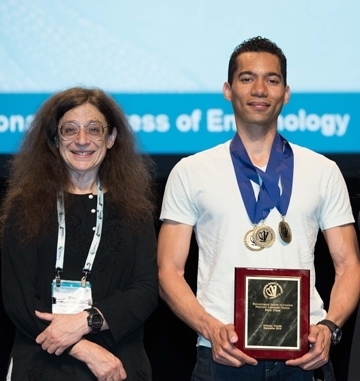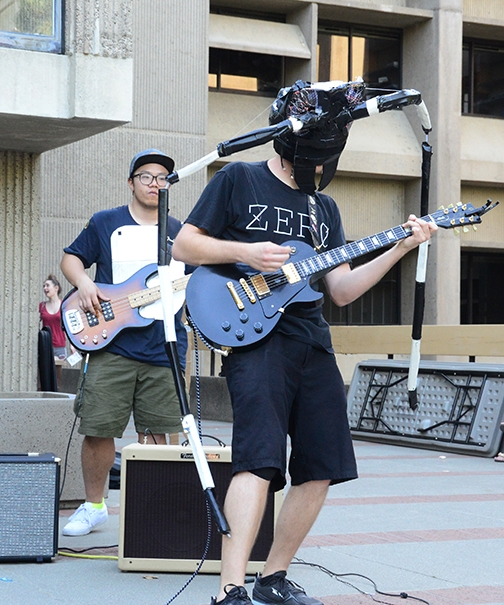- Author: Kathy Keatley Garvey
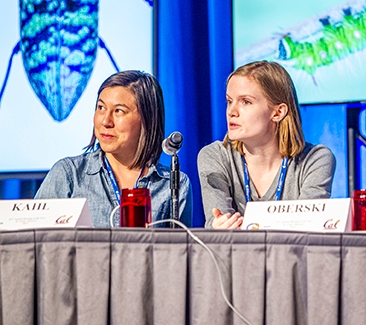
The team was eliminated in the first round. Some logistics issues--microphone mishaps and difficulty hearing the questions (issues later resolved)--complicated the session.
Previously the UC team won three national championships. This year the University of Florida team triumphed.
The Linnaean Games, launched in 1983, are lively question-and-answer, college bowl-style competitions on entomological facts and played by winners of the ESA branch competitions. The teams score points by correctly answering random questions.
The 2019 UC team, captained by Ralph Washington Jr., a UC Berkeley public policy graduate student who received his bachelor's degree in entomology at UC Davis, included five UC Davis doctoral students in entomology: Brendon Boudinot, Zachary Griebenow and Jill Oberski, all of the Phil Ward lab, UC Davis Department of Entomology and Nematology; and alternates Miles Dakin of the Christian Nansen lab and Hanna Kahl of the Jay Rosenheim lab.
Washington captained all four recent teams, and Boudinot helped anchor all of them.
The record:
- 2018: UC won the national championship (link to news story) in Vancouver, B.C., defeating Texas A&M Graduates, with Washington captaining the team and joined by Boudinot, Oberski and Griebenow, and Emily Bick (who received her doctorate this year) of the Christian Nansen lab. (No video of the championship round)
- 2017: The UC team did not compete. (Texas A&M won the national championship; see championship round on YouTube)
- 2016: UC won the national and international championships at the University of Florida, at the joint and international meeting of ESA and the International Congress of Entomology (ICE), defeating the University of Georgia. (See championship round on YouTube)
- 2015: UC won the national championship at the games held in Minneapolis, Minn., defeating the University of Florida. (See championship round on YouTube)
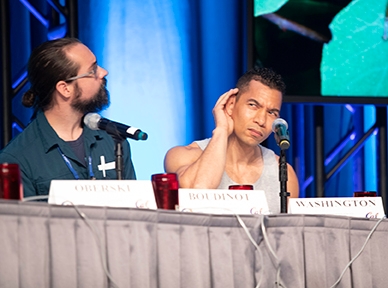
Some of the previous questions asked of the UC team during the championship rounds:
Question: What is the smallest insect that is not a parasite or parasitoid?
Answer: Beetles in the family Ptiliidae.
Question:Some species of mosquitoes lay eggs that can undergo diapause or aestivation. Give at least three cues that trigger the aquatic eggs to hatch.
Answer: Temperature, immersion in water, concentration of ions or dissolved solutes.
Question: Chikungunya is an emerging vector-borne disease in the Americas. Chikungunya is derived from the African Language Makonde. What means Chikungunya in Makonde?
Answer: Bending up.
Question: A Gilson's gland can be found in what insect order?
Answer: Trichoptera
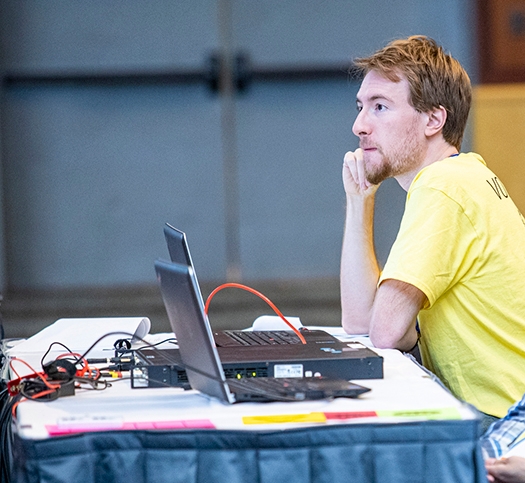
Answer: Cassidinae.
Question: The first lepidopteran sex pheromone identified was bombykol. What was the first dipteran sex pheromone identified? Give the trade or chemical name.
Answer: Muscalure, Z-9-Tricosene. It is also one of the chemicals released by bees during the waggle dance.
Question: What famous recessive gene was the first sex-linked mutation demonstrated in Drosophila by T.H. Morgan?
Answer: White
Question: Cecidomyiidae are known as the gall flies. What is unique about the species Mayetiola destructor, and what is its common name?
Answer: Mayetiola destructor is the Hessian Fly, a tremendous pest of wheat. It does not form galls.
Question: Nicrophorus americanus is listed under what legislative act?
Answer: The Endangered Species Act
Question: In what insect order would you find hemelytra?
Answer: The order Hemiptera.
Question: A 2006 Science article by Glenner et al. on the origin of insects summarized evidence that Hexapods are nothing more than land-dwelling crustaceans, which is to say that the former group Crustacea is paraphyletic with respect to the Hexapoda. What hierarchical name has been used to refer to this clade?
Answer: Pancrustacea
Question: What are the three primary conditions that define eusociality?
Answer: Cooperative brood care, overlapping generations, and reproductive division of labor
Founded in 1889, ESA is the world's largest organization serving the professional and scientific needs of entomologists and individuals in related disciplines. It is comprised of more than 7000 members, who are affiliated with educational institutions, health agencies, private industry, and government. Members are researchers, teachers, extension service personnel, administrators, marketing representatives, research technicians, consultants, students, pest management professionals, and hobbyists.
Resources:
Origin of Linnaean Games (Richard Levine in American Entomologist)
Previous Winners (Entomological Society of America)
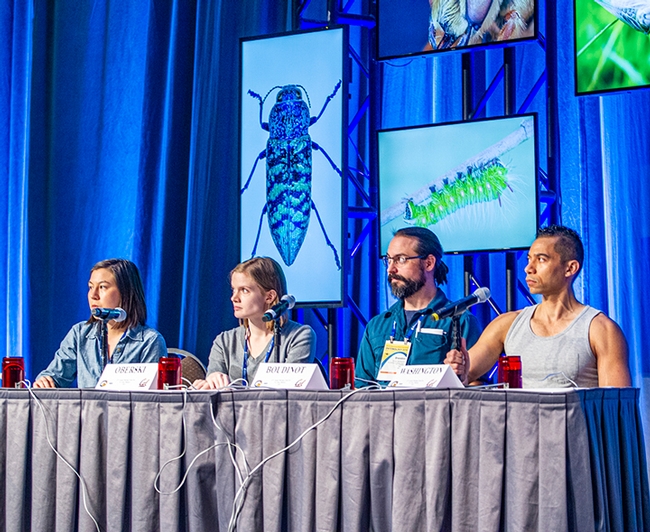
- Author: Kathy Keatley Garvey
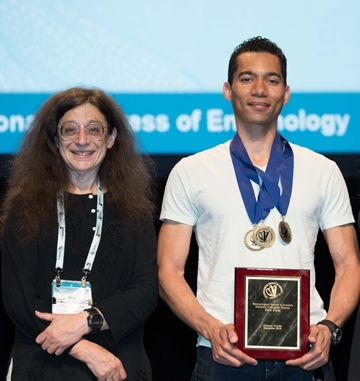
The Linnaean Games, launched in 1983, are lively question-and-answer, college bowl-style competitions on entomological facts and played by winners of the ESA branch competitions. The teams score points by correctly answering random questions.
This year's UC team, captained by Ralph Washington Jr., a UC Berkeley public policy graduate student who received his bachelor's degree in entomology at UC Davis, includes five UC Davis doctoral students in entomology: Brendon Boudinot, Zachary Griebenow and Jill Oberski, all of the Phil Ward lab, UC Davis Department of Entomology and Nematology; and alternates Miles Dakin of the Christian Nansen lab and Hanna Kahl of the Jay Rosenheim lab.
Washington has captained all three winning teams, and Boudinot has helped anchor all of them.
The record:
- 2018: UC won the national championship (link to news story) in Vancouver, B.C., defeating Texas A&M Graduates, with Washington captaining the team and joined by Boudinot, Oberski and Griebenow, and Emily Bick (who received her doctorate this year) of the Christian Nansen lab. (No video of the championship round)
- 2017: The UC team did not compete. (Texas A&M won the national championship; see championship round on YouTube)
- 2016: UC won the national and international championships at the University of Florida, at the joint and international meeting of ESA and the International Congress of Entomology (ICE), defeating the University of Georgia. (See championship round on YouTube)
- 2015: UC won the national championship at the games held in Minneapolis, Minn., defeating the University of Florida. (See championship round on YouTube)
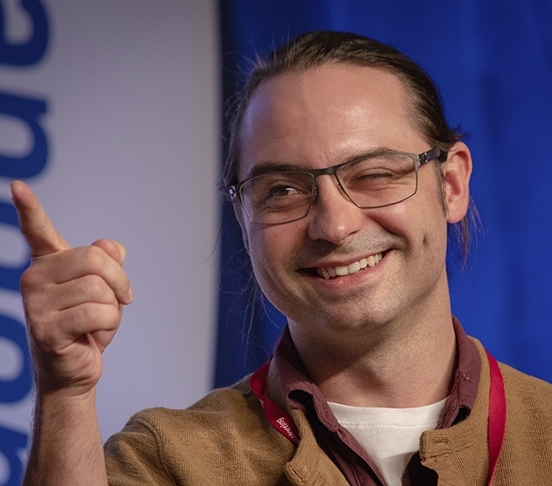
All branches of ESA conduct a Linnaean Games competition, with each branch sending the winner and the second-place winner to the nationals. The UC team has won the Pacific Branch (PBESA) competition multiple times. PBESA encompasses 11 Western U.S. states, plus several U.S. territories and parts of Canada and Mexico.
Some of the previous questions asked of the UC team during the championship rounds:
Toss-Up Question: What is the smallest insect that is not a parasite or parasitoid?
Answer: Beetles in the family Ptiliidae.
Bonus Question:Some species of mosquitoes lay eggs that can undergo diapause or aestivation. Give at least three cues that trigger the aquatic eggs to hatch.
Answer: Temperature, immersion in water, concentration of ions or dissolved solutes.
Toss-Up Question: Chikungunya is an emerging vector-borne disease in the Americas. Chikungunya is derived from the African Language Makonde. What means Chikungunya in Makonde?
Answer: Bending up.
Toss-Up Question: A Gilson's gland can be found in what insect order?
Answer: Trichoptera
Toss-Up Question: Certain Chrysomelid larvae carry their feces as a defensive shield. To what subfamily do these beetles belong?
Answer: Cassidinae.
Bonus Question: The first lepidopteran sex pheromone identified was bombykol. What was the first dipteran sex pheromone identified? Give the trade or chemical name.
Answer: Muscalure, Z-9-Tricosene. It is also one of the chemicals released by bees during the waggle dance.
Toss-Up Question: What famous recessive gene was the first sex-linked mutation demonstrated in Drosophila by T.H. Morgan?
Answer: White
Bonus Question: Cecidomyiidae are known as the gall flies. What is unique about the species Mayetiola destructor, and what is its common name?
Answer: Mayetiola destructor is the Hessian Fly, a tremendous pest of wheat. It does not form galls.
Toss-Up Question: Nicrophorus americanus is listed under what legislative act?
Answer: The Endangered Species Act
Toss-Up Question: In what insect order would you find hemelytra?
Answer: The order Hemiptera.
Toss-Up Question: The subimago stage is characteristic of what insect order?
Answer: The order Ephemeroptera
Bonus Question: A 2006 Science article by Glenner et al. on the origin of insects summarized evidence that Hexapods are nothing more than land-dwelling crustaceans, which is to say that the former group Crustacea is paraphyletic with respect to the Hexapoda. What hierarchical name has been used to refer to this clade?
Answer: Pancrustacea
Toss-Up Question: What are the three primary conditions that define eusociality?
Answer: Cooperative brood care, overlapping generations, and reproductive division of labor
In addition to serving on the Linnaean Games Team, Boudinot will be honored as the PBESA recipient of the John Henry Comstock Award, the top graduate student award. PBESA is one of six branches of the ESA.
Founded in 1889, ESA is the world's largest organization serving the professional and scientific needs of entomologists and individuals in related disciplines. It is comprised of more than 7000 members, who are affiliated with educational institutions, health agencies, private industry, and government. Members are researchers, teachers, extension service personnel, administrators, marketing representatives, research technicians, consultants, students, pest management professionals, and hobbyists.
Resources:
Origin of Linnaean Games (Richard Levine in American Entomologist)
Previous Winners (Entomological Society of America)
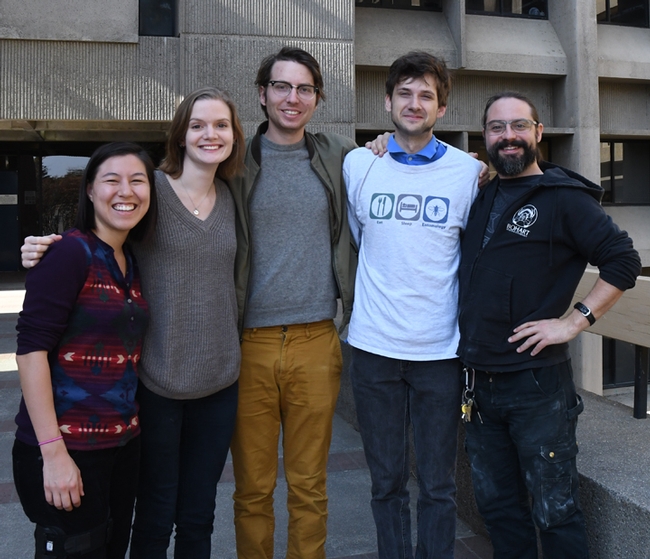
- Author: Kathy Keatley Garvey
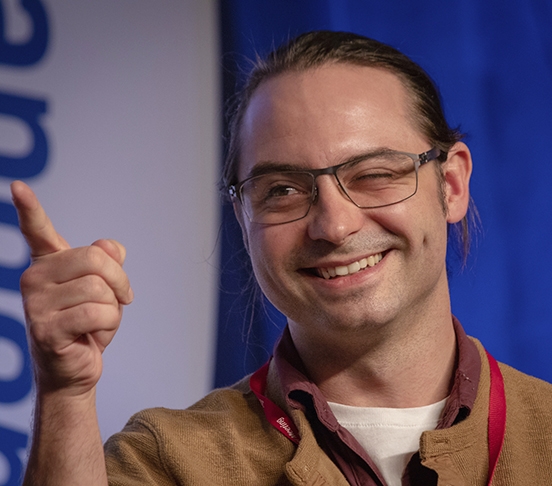
This makes the third year that a UC Davis-based team has won the national championship.
"In the final, UC defeated Texas A&M (graduate students), 140-20," said Joe Rominiecki, manager of communications for the Entomological Society of America (ESA). "UC defeated the University of Florida 110-100 in the semifinal round. In the preliminary round, UC defeated the Texas A&M undergrad team."
The Linnaean Games, launched in 1983, are lively question-and-answer, college bowl-style competitions on entomological facts and played by winners of the ESA branch competitions. The teams score points by correctly answering random questions.
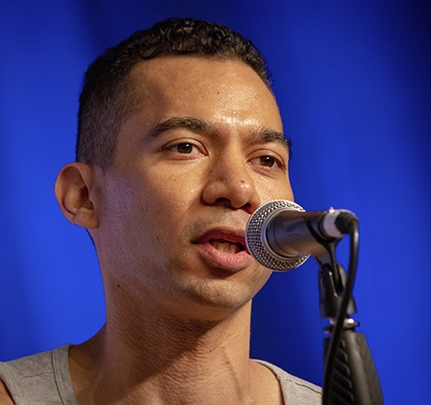
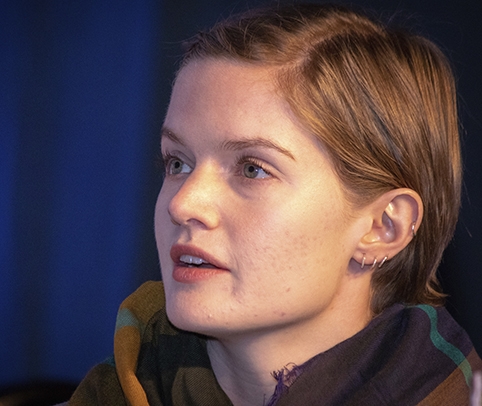
"Before us, there was a sudden death double overtime game (Texas A&M grads vs University of Delaware) which was really exciting," Boudinot said.
Griebenow recalled that among the questions the UC team correctly answered in the championship round:
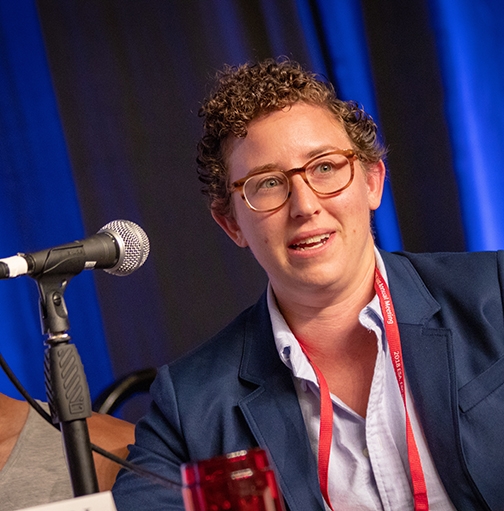
Answer: Arctic tundra
Question: The Passandridae are a family of beetles. What is unusual about their larvae?
Answer: The larvae are ectoparasitoids of wood-boring insects.
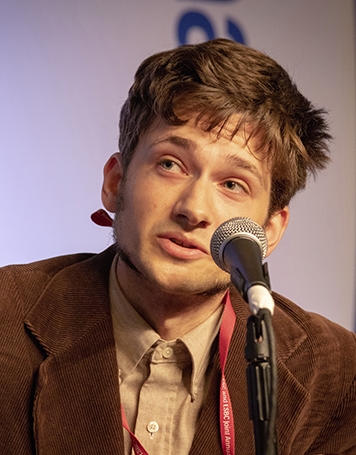
Each ESA branch hosts a Linnaean game competition at its annual meeting. The winning team and the runner-up both advance to the national competition. The national preliminaries took place Sunday, Nov. 11 while the finals got underway at 5 p.m. on Tuesday, Nov. 13.
Members of the winning team will each receive a gold medal and and a plaque for the team's department.
To get to the national finals, the UC team won the regional championship hosted by the Pacific Branch of ESA at its meeting June 10-13 in Reno. They defeated Washington State University in a sudden death overtime to win the title.
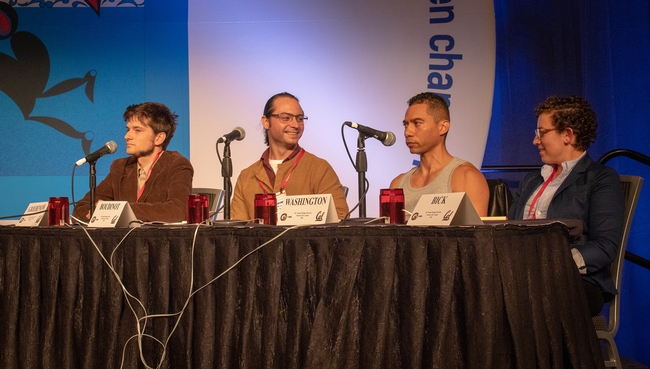
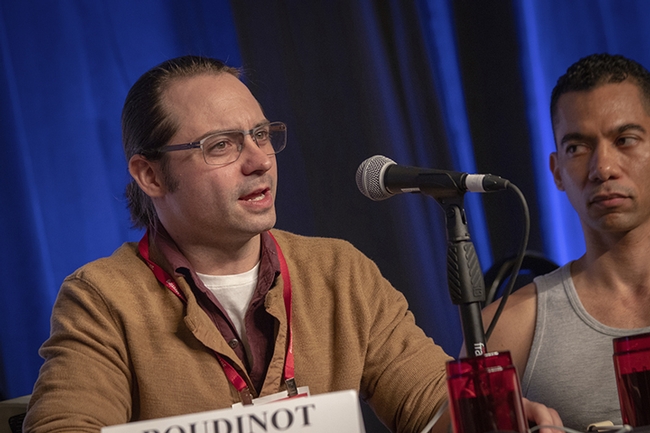
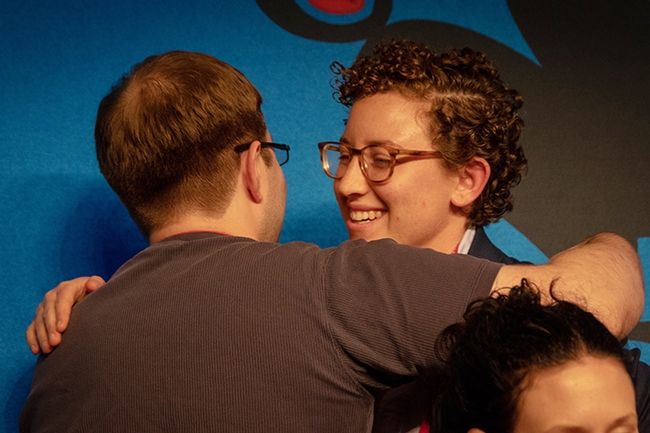
- Author: Kathy Keatley Garvey
The UC Berkeley-UC Davis Linnaean Games Team, comprised of graduate students from UC Berkeley and UC Davis, won the championship at the regional Linnaean Games hosted by the Pacific Branch, Entomological Society of America (PBESA) at its meeting June 10-13 in Reno.
The Linnaean Games are a lively question-and-answer, college bowl-style competition on entomological facts played between university-sponsored student teams. The teams score points by correctly answering random questions.
The team, captained by Ralph Washington Jr., a graduate student in public policy at UC Berkeley, (formerly a graduate student at UC Davis), included UC Davis doctoral students Brendon Boudinot, Zachary Griebenow and Jill Oberski, all of the Phil Ward lab, and Emily Bick of the Christian Nansen lab.
The UC Berkeley-UC Davis team defeated Washington State University (WSU) in a sudden death overtime to win the title.
“Davis vs WSU was the final game of the night,” related Boudinot. “This went into Sudden Death as the teams were tied 90-90 after several UC Davis interrupts reduced their point total. We came back from DOWN to tie at about 15th question, and the sudden death question was specifically selected to be challenging. The key details were ‘Dutch ... microscopist from the 17th century.' WSU buzzed in on the interrupt and stated "Leeuwenhoek," which was incorrect, leading to their elimination. The correct answer was Swammerdam."
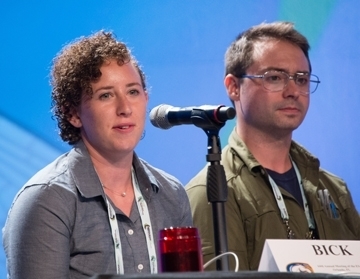
Some of the questions asked at this year's PBESA Linnaean Games, as related by Ralph Washington Jr.:
Question: Name the fungal agent that grows naturally in soils throughout the world and causes white muscardine disease and is commercially packaged as a biological insecticide for the control of termites, whiteflies, and other insect pests?
Answer: Beauveria bassiana
Question: Name the process through which spiders use silk to fly and disperse.
Answer: Ballooning.
Question: Where are you most likely to encounter a rheophilic insect?
Answer: In moving streams.
The UC Davis Linnaean team, captained by Washington, won the national championship in both 2015 and 2016. Boudinot served as a member of both championship teams. Bick was a member of the 2016 team, which also was comprised of graduate students Jéssica Gillung and Ziad Khouri, who study with Lynn Kimsey, director the Bohart Museum of Entomology.
The list of national champions over the last five years:
2017
1st Place: Texas A&M
2nd Place: The Ohio State
2016
1st Place: University of California, Davis
2nd Place: University of Georgia
2015
1st Place: University of California, Davis
2nd Place: University of Florida
2014
1st Place: North Carolina State University
2nd Place: University of Florida
2013
1st Place: University of California- Riverside
2nd Place: Mississippi State University
The Pacific Branch of ESA is comprised of 11 states (Alaska, Arizona, California, Hawai'i, Idaho, Montana, Nevada, Oregon, Utah, Washington, and Wyoming), plus U.S. territories (American Samoa, the Federated States of Micronesia, Guam, Johnston Atoll, Commonwealth of the Northern Mariana Islands, Midway Islands and Wake Island) and parts of Canada (Alberta, British Columbia, Northwest Territories, Saskatchewan and Yukon) and parts of Mexico (Baja California, Baja California Sur, Sinaloa and Sonora).
Founded in 1889, the 7000-member ESA is the largest organization in the world serving the professional and scientific needs of entomologists and individuals in related disciplines. Its members are affiliated with educational institutions, health agencies, private industry, and government. Members are researchers, teachers, extension service personnel, administrators, marketing representatives, research technicians, consultants, students, pest management professionals, and hobbyists.
Resources:
- Watch the 2016 National Linnaean Games Championship Round (won by UC Davis), posted on YouTube
- Watch the 2015 National Linnaean Games Championship Round (won by UC Davis), posted on YouTube
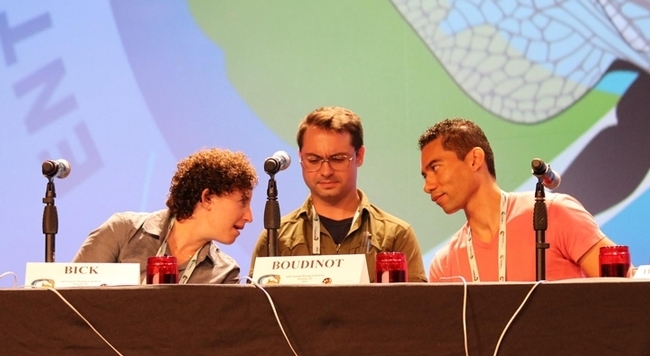
- Author: Kathy Keatley Garvey
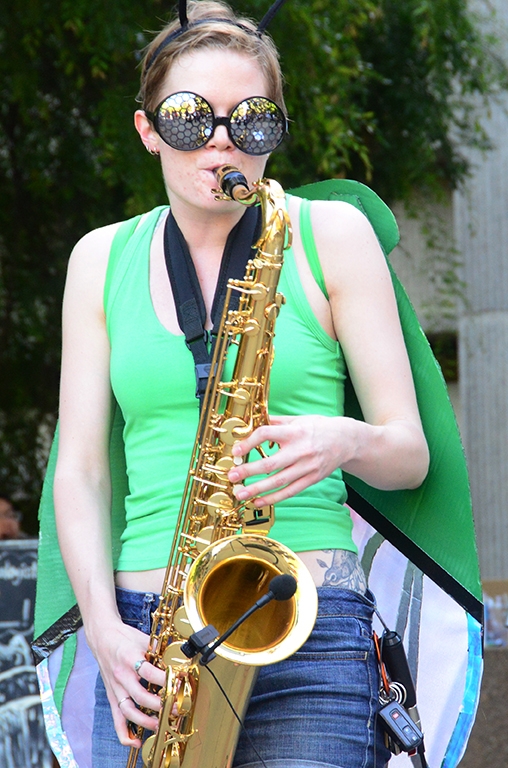
But have you ever heard of a song featuring the three-cornered alfalfa hopper, Spissistilus festinus, and another one spotlighting the male insect organ, the aedeagus?
And composed by a graduate student at the University of California, Davis, and performed by seven insect-attired UC Davis doctoral students?
That's what happened during the recent UC Davis Picnic Day celebration when the septet gathered in front of Briggs Hall to perform three songs composed by talented musician and entomologist Michael Bollinger, enrolled in the master's degree program, UC Davis Department of Entomology and Nematology. The group performed Bollinger's compositions, “E Major Homeboy (Spissistilus festinus),” “Tragedy (of the Clocks)," and "Jackson's Song (Aedeagal Bits)," as well as a cover song, “Island in the Sun” by Weezer.
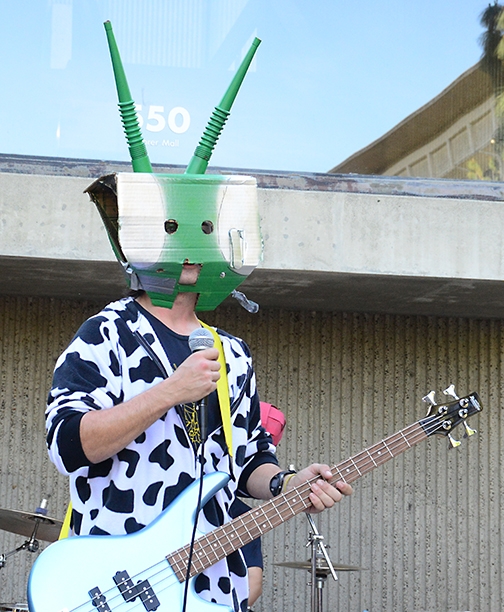
The performance went well. Very well. So did Picnic Day.
“My goal was to make sure Picnic Day worked overall, and that, for the band, the sounds were balanced and each of the elements could be heard,” said emcee and band member Brendon Boudinot, president of the UC Davis Entomology Graduate Student Association (EGSA) and a doctoral candidate specializing in ant evolution and classification.
The “Entomology at UC Davis” exhibit at Briggs Hall, the work of the UC Davis Department of Entomology and Nematology, won the campuswide “At One With Nature” category. And the band? It drew loud applause and high praise from the standing crowd.
Their name: “The Entomology Band.” (No take-offs of the iconic “Beatles,” “Buddy Holly and the Crickets” or “Adam and the Ants.”)
Bollinger's original songs capped a day of insect-related activities that included maggot art, cockroach races, nematode identification, scavenger hunts, and honey tasting.
- Molecular geneticist and drummer Yao “Fruit Fly” Cai of the Joanna Chiu lab, dressed in a fruit fly costume, Drosophila melanogaster, which he described as “our favorite model organism in Insecta!”
- Bark beetle specialist and rhythm guitarist Jackson “Darth Beetle” Audley of the Steve Seybold lab, portrayed an Asian longhorned beetle, Anoplophora glabripennis
- Honey bee researcher and bass guitarist Wei “Silverfish” Lin of the Brian Johnson lab, wore a costume that celebrated his moniker, Lepisma saccharina, a small, wingless insect in the order Zygentoma
- Ant specialist and keyboard artist Zachary “Leptanilla” Griebenow of the Phil Ward lab, dressed as “a generic male leptanilline ant (Formicidae: Leptanillinae).” He said: “The yellow color “is not anywhere near so vivid in real life.”
- Systematist and tenor saxophonist Jill “Jillus Saximus” Oberski of the Phil Ward lab, dressed as a “generalized heteropteran,” which she described as “most likely a member of the family Acanthosomatidae (shield bug) or Pentatomidae (stink bug). My family and friends have called me Jillybug, so I came to be the band's representative of Hemiptera.”
- Molecular geneticist and vocalist Christine “The Clock” Tabuloc of the Joanna Chiu lab, wrapped herself in butterfly wings
- Ant specialist and bass guitarist Brendon “Hype Man-tis” Boudinot of the Phil Ward lab, dressed in a green helmet, a blue and gold EGSA bee shirt and a UC Davis cow costume to showcase his department and campus-wide love of bovines.
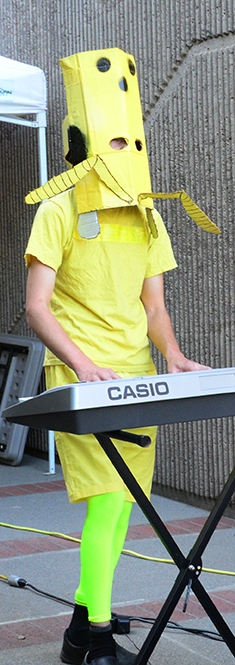
The seven band members share a love of music.
Drummer Yao Cai, who grew up in Southeast China and holds an undergraduate degree in plant protection and a master's degree from China Agricultural University, has been playing drums since age 17. “We formed as a short-lived band for a show. After that, I realized that I really wanted to keep playing and improved my drum techniques. Thus, we started another band in college and played for six years in college, as an undergrad and graduate student.
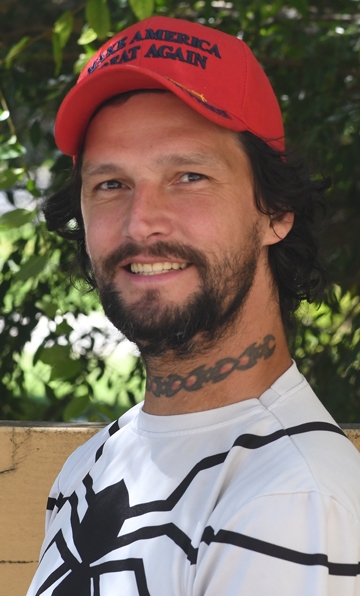
“It is very interesting that I was in a band that was the first band in Department of Entomology in China Agricultural University and now we started the first band in Department of Entomology at UC Davis.”
Rhythm guitarist Jackson Audley said he “started learning to play the guitar when I was about 11-12 ish. The first band I joined was a Blink-182 cover band, in which I played the bass guitar, and we played together for most of eighth grade. Then in early high school I joined a Smashing Pumpkins/Radiohead cover band as the second guitarist. Shortly after joining that band, we started making predominantly original music. By the end of high school, we had played a few small shows around the Atlanta area and had recorded a few songs. Unfortunately, the band did not survive the transition into university and we broke up.”
Since then he's mostly played “for fun and I like to jam with folks.”
Jill Oberski, a native of Twin Cities, grew up mostly in Chaska, Minn., “a sleepy suburb of Minnesota.” She received her bachelor's degree in Macalester College in Saint Paul, Minn., where she double-majored in biology and German studies.
“I started playing the piano in kindergarten, and switched to saxophone in fifth grade,” Oberski related. “I played classical and jazz in my school bands from sixth grade through college, and pit orchestra / pep band / marching band in high school as well. I've always been better at classical than rock/jazz/Latin.”
“I probably reached my highest point in late high school, when I served as co-section leader for the saxes in the Minnesota all-state symphonic band--we even got to play a concert in Minneapolis' orchestra hall. These days I'm only involved in the entomology band and some very casual ukulele playing.”
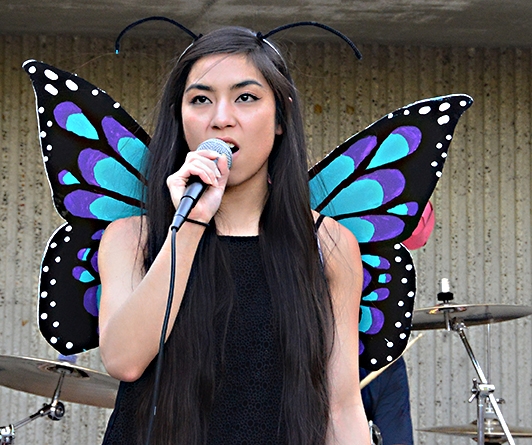
Brendon Boudinot, who received his bachelor's degree in entomology at the Evergreen State College, Olympia, Wash., performed on a metallic sky-blue bass. “I just love art,” he said. “Music is a family thing for me in a number of different ways. Although I have played instruments alone or in groups for many years, nothing really clicked in me until I heard Michael and Yao play together. They shred.”
“The Entomology Band is special to me, and I am just glad I could be a part of it.”
Vocalist Christine Anne Tabuloc, who grew up in the Los Angeles area and received her bachelor's degree from UC Davis in biochemistry and molecular biology, says she does not play an instrument. “I'm far less talented than everyone else in the group,” she quipped. “I've been singing for as long as I can remember. I've been writing lyrics since elementary school. However, I never got around to getting music written for them. I was in choir before and have had solos but that's pretty much it.”
Bass guitarist Wei Lin, who grew up in Xiamen, "a beautiful island in southern China," received his bachelor's and master's degree in China Agricultural University, majoring in plant protection and entomology. “This was my first experience in a band. I just started to learn bass last year when this band was built.”
Following the four-set gig, Boudinot told the appreciative crowd, “That's all we know!”
Pending performances? “The band,” he said, “is on hiatus.”
Or diapause.
